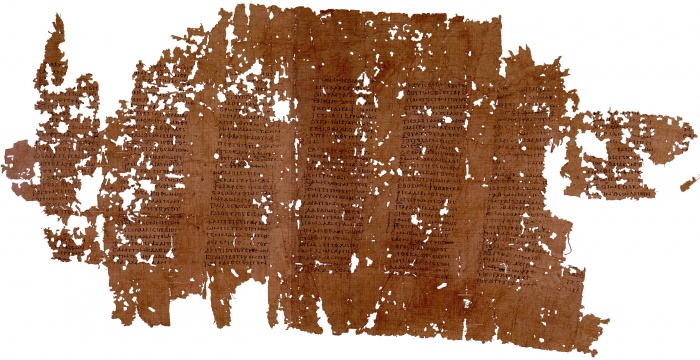bookroll in Barok 2014
e, a vessel, a
medium, a frame containing text embedded between straight, less or more
explicit, horizontal and vertical borders. Even before the material of the
page such as papyrus and paper appeared, the text was already contained in
lines and columns, a structure which we have learnt to perceive as a grid. The
idea of the grid allows us to view text as being structured in lines and
pages, that are in turn in hand if something is to be referred to. Pages are
counted as the distance from the beginning of the book, and lines as the
distance from the beginning of the page. It is not surprising because it is in
accord with inherent quality of its material medium -- a sheet of paper has a
shape which in turn shapes a body of a text. This tradition goes as far as to
the Ancient times and the bookroll in which we indeed find textual grids.
[](/File:Papyrus_of_Plato_Phaedrus.jpg)
[](/File:Papyrus_of_Plato_Phaedrus.jpg "Enlarge")
A crucial difference between print and digital is that text files such as HTML
documents nor markdown documents nor database-driven texts did inherit this
quality. Their containers are simply not structured into pages, precisely
because of the nature of their materiality as media. Files are written on
memory drives in scattered chunks, beginning at point A and ending at point B
of a drive, continuing from C until D, and so on. Where does each of these
chunks start is ultimately independent from wha
as the
beginning of the text, the beginning of the chapter, or the beginning of the
paragraph. The second option is to make a distinction between operators and
operands, and count only in operands. Here there are further options where to
make the line between them. We can consider as operands only characters with
phonetic properties -- letters, numbers and symbols, stripping the text from
operators that are there to shape sonic and visual rendering of the text such
as whitespaces, commas, periods, HTML and markdown and other tags so that we
are left with the body of the text to count in. This would mean to render
operators unreferrable and count as in _scriptio continua_.
_Scriptio continua_ is a very old example of the linear onedimensional
treatment of the text. Let's look again at the bookroll with Plato's writing.
Even though it is 'designed' into grids on a closer look it reveals the lack
of any other structural elements -- there are no spaces, commas, periods or
line-breaks, the text is merely one flow, one long line.
_Phaedrus_ was written in the fourth century BC (this copy comes from the
second century AD). Word and paragraph separators were reintroduced much
later, between the second and sixth century AD when rolls were gradually
transcribed into codices that were bound as pages and numbered (a dramatic
change in publishing comparable to digital changes today).[2]
'Reference-linking' has not been prominent in discussions about sharing books
online and I only came to realise its significance during my preparations for
this event. There is a tremendous amount of very old,
Display 200 300 400 500 600 700 800 900 1000 ALL characters around the word.